|
Dispatch 5: Work Underway |
| |
Andrey ProshutinskyAugust 12-14, 2003
 |
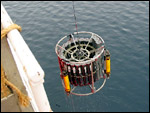 |
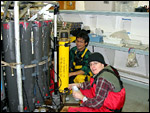
|
| CTD (Conductivity, temperature, depth) instrument and carrousel block with twenty four 10-litter bottles for collection of water samples is coming on board (left). Celine Gueguen and Naoaki Uzaka from the International Arctic Research Center collect water samples for the analysis of dissolved carbon and chlorophyll in the CTD laboratory of our ship (right). |
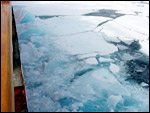 |
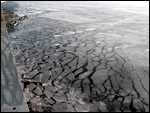 |
| From time to time, the concentration of sea ice increases and we have to break through sea ice floes. Sometimes the ice thickness exceeds 1 meter (left, see pieces of ice in the vicinity of the ship) but other times it is thin (20-30 cm) and breaks easily without significantly influencing the speed of the ship (right). |
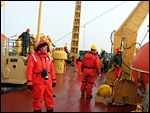 |
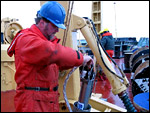 |
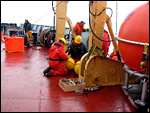 |
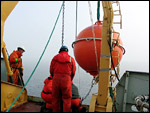 |
WHOI (Woods Hole Oceanographic Institution) mooring deployment. This is our southernmost mooring located at 75°N and 150°W, with total a depth of 3800 meters.
|
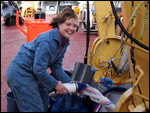 |
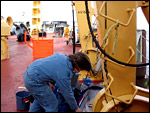 |
| Camille Coray from the University of Alaska Fairbanks prepares Bongo nets for sampling zooplankton on August 13th, 2003. |
We performed observations of water properties on August 12th and 13th. Six oceanographic stations were occupied with a spatial interval from 30 to 60 nautical miles and water samples were taken at various points from the surface to the bottom at various depths.
We successfully deployed our first mooring (75°N and 150°W) at depth of 3,800 meters (some photographs of this procedure are shown). The weather and sea ice conditions are very good. Each day we receive updated information from the Canadian National Weather center and also some radar satellite images of sea ice from the University of Alaska, Fairbanks.
We also receive sea ice drift and ice edge location forecasts (up to six days in advance) from the Arctic and Antarctic Research Institute located in St. Petersburg, Russia.
Unfortunately, we have not yet encountered any birds, seals, polar bears or other Arctic animals. This area of the deep ocean does not have enough nutrients and solar radiation to support the growth of the single-celled plants in the ocean known as phytoplankton. Phytoplankton form the base of the food chain. Without them, higher trophic-level creatures cannot survive.
In addition, the severe climate with its low temperatures and year-round ice presence is not favorable for many life forms. Early estimates of phytoplankton growth rates from the USA drifting polar station T3 organized on an ice island in the 1970s indicated that the Arctic Ocean had the lowest values of phytoplankton growth of all oceans.
More recent measurements have indicated that the early values were underestimated by a factor of 2-10 (or climate has changed). Thus, some biological studies continue on our expedition. Camille Coray of the University of Alaska Fairbanks is responsible for collecting zooplankton using Bongo nets.
|
|
Last updated: October 7, 2019 |












